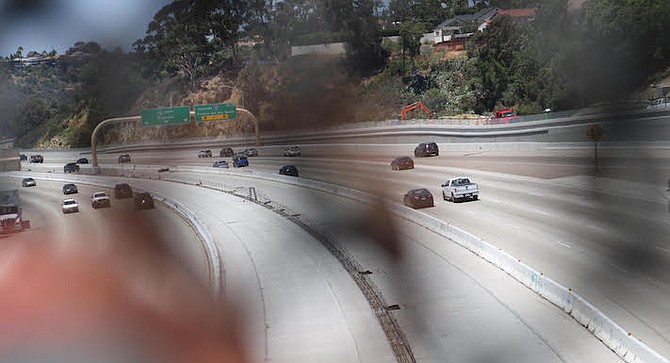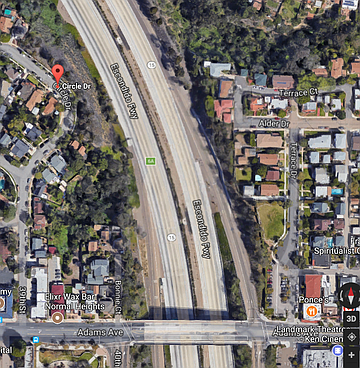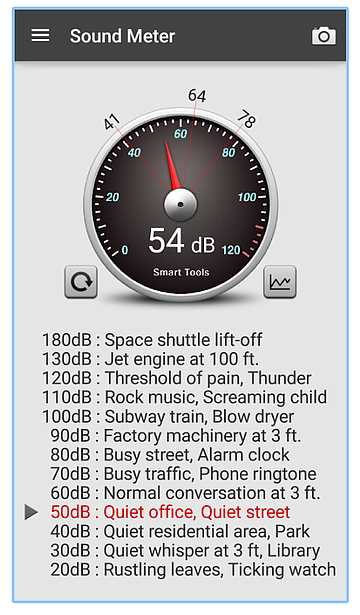 Facebook
Facebook
 X
X
 Instagram
Instagram
 TikTok
TikTok
 Youtube
Youtube

“The noise level has increased throughout the day and night,” said Shannon Moran, “I used to be able to sleep with the windows down and now I either have [to use a] loud ambient noise machine or ear plugs.”

Moran, 51, was referring to the noise level coming from the 15 Freeway and the new State Route 15 Commuter Bikeway which are below the backyard of her home at Circle Drive in Normal Heights.
“When I bought this house in November 2015,” she said, “the noise level sounded like waves and was not intrusive to enjoying the backyard [and as of July 1] weekend days are noticeably louder, as is evening and mornings.”

John from Kensington, walks his dog across the Adams Avenue overpass everyday and passes the northbound freeway and the closed bikeway entrance. “I think that maybe the extra noise is coming from the new [bikeway] walls which bounce the [freeway traffic] noise to Normal Heights.”

John and Moran are referring to the newly constructed walls that separate the freeway from the bikeway, and some of the 5- to 12-foot (tall) walls that rest on the Kensington hillside. In between the cement walls lies the new one-mile bikeway that has an entrance on Adams Avenue and another down the hill at Camino Del Rio South.
“[There is] no way [that the] new bikeway created more noise,” said David Hayes, “I noticed those recent complainers never spoke up until it was nearly finished! Fools; the walls for the bikeway have been completed for months.”

Hayes, 49, is an operations manager by trade and comes from an “avid cycle commuting family.” He lives north of Moran by I-8. Hayes recorded the sound pressure level in their neighborhood via a smartphone app called Sound Meter. The app “uses your embedded microphone to measure noise volume in decibels (db), and shows a reference,” states the app-download page – which has an 82 percent approval record.
“The noise from the 805 and 15 [freeways] combine into a background hum measuring 55 to 61 db at all times outside [of] my home,” Hayes said.
Moran measured the noise in her backyard and said that it hits about 60 db routinely.
The Sound Meter download-page states that 50 db is equivalent to a quiet office or street, and 60 db would be a normal conversation at three feet. Double Moran’s noise assessment and the 120 db is like thunder or the threshold of pain.
A few neighbors agreed with Moran’s “higher noise level” assessment, but John says that it “could be a placebo effect.”
The neighbors who agreed with Moran suggested solutions like bushes and a cover (over the freeway) to absorb the noise.
Jordan Pier, who works as an audio service technician, offered an easier sound-absorbent method. “[They can apply] paints that are textured to a surface (the wall) and that will absorb the noise. That might be something that you can approach the city with.”
Pier has been tuning home audio systems for 10 years out of Classic Audio Repair on Adams Avenue, which is less than a mile away from where Moran and Hayes live. Part of his job is to adjust speaker locations and their surroundings (furniture, lamp shades, frames, and plants).
“If they are putting up a large wall that would be a major refractor for sound,” he said, “and depending on what time of the day that is and the thickness of the atmosphere, the sound can carry and propagate and bounce off the walls. If the wall is directly opposite from the residents; that would amplify sound.”
Pier added that without the retaining wall, the freeway traffic noise can be about 80-85 db, but with the wall in place, that noise can elevate to 90-95 db.
Moran and Hayes said that they did not measure the db prior to the new bikeway walls going up.
“So they have no baseline before the wall was put up, and an acceptable level would be at about 80 db for outdoor noise,” Pier said; which Sound Meter equates to the noise of a busy street or an alarm clock.


“The noise level has increased throughout the day and night,” said Shannon Moran, “I used to be able to sleep with the windows down and now I either have [to use a] loud ambient noise machine or ear plugs.”

Moran, 51, was referring to the noise level coming from the 15 Freeway and the new State Route 15 Commuter Bikeway which are below the backyard of her home at Circle Drive in Normal Heights.
“When I bought this house in November 2015,” she said, “the noise level sounded like waves and was not intrusive to enjoying the backyard [and as of July 1] weekend days are noticeably louder, as is evening and mornings.”

John from Kensington, walks his dog across the Adams Avenue overpass everyday and passes the northbound freeway and the closed bikeway entrance. “I think that maybe the extra noise is coming from the new [bikeway] walls which bounce the [freeway traffic] noise to Normal Heights.”

John and Moran are referring to the newly constructed walls that separate the freeway from the bikeway, and some of the 5- to 12-foot (tall) walls that rest on the Kensington hillside. In between the cement walls lies the new one-mile bikeway that has an entrance on Adams Avenue and another down the hill at Camino Del Rio South.
“[There is] no way [that the] new bikeway created more noise,” said David Hayes, “I noticed those recent complainers never spoke up until it was nearly finished! Fools; the walls for the bikeway have been completed for months.”

Hayes, 49, is an operations manager by trade and comes from an “avid cycle commuting family.” He lives north of Moran by I-8. Hayes recorded the sound pressure level in their neighborhood via a smartphone app called Sound Meter. The app “uses your embedded microphone to measure noise volume in decibels (db), and shows a reference,” states the app-download page – which has an 82 percent approval record.
“The noise from the 805 and 15 [freeways] combine into a background hum measuring 55 to 61 db at all times outside [of] my home,” Hayes said.
Moran measured the noise in her backyard and said that it hits about 60 db routinely.
The Sound Meter download-page states that 50 db is equivalent to a quiet office or street, and 60 db would be a normal conversation at three feet. Double Moran’s noise assessment and the 120 db is like thunder or the threshold of pain.
A few neighbors agreed with Moran’s “higher noise level” assessment, but John says that it “could be a placebo effect.”
The neighbors who agreed with Moran suggested solutions like bushes and a cover (over the freeway) to absorb the noise.
Jordan Pier, who works as an audio service technician, offered an easier sound-absorbent method. “[They can apply] paints that are textured to a surface (the wall) and that will absorb the noise. That might be something that you can approach the city with.”
Pier has been tuning home audio systems for 10 years out of Classic Audio Repair on Adams Avenue, which is less than a mile away from where Moran and Hayes live. Part of his job is to adjust speaker locations and their surroundings (furniture, lamp shades, frames, and plants).
“If they are putting up a large wall that would be a major refractor for sound,” he said, “and depending on what time of the day that is and the thickness of the atmosphere, the sound can carry and propagate and bounce off the walls. If the wall is directly opposite from the residents; that would amplify sound.”
Pier added that without the retaining wall, the freeway traffic noise can be about 80-85 db, but with the wall in place, that noise can elevate to 90-95 db.
Moran and Hayes said that they did not measure the db prior to the new bikeway walls going up.
“So they have no baseline before the wall was put up, and an acceptable level would be at about 80 db for outdoor noise,” Pier said; which Sound Meter equates to the noise of a busy street or an alarm clock.
Comments